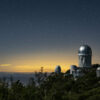A new series of supercomputer simulations has offered an answer to the mystery of the origins of Saturn’s rings—one that involves a massive collision in the recent history of the 4.5 billion-year-old solar system.
According to new research published in The Astrophysical Journal involving NASA and Durham and Glasgow universities, Saturn’s rings could have evolved from the debris of two progenitor icy moons that collided and shattered only a few hundred million years ago.
They would likely have been similar in size to two of Saturn’s current moons, Dione and Rhea.
Debris that didn’t end up in the rings could also have contributed to the formation of some of Saturn’s present-day moons.
Most contemporary high-quality measurements of Saturn have come from the Cassini spacecraft. It spent 13 years studying the planet and its systems after entering Saturn’s orbit in 2004.
The Cassini craft captured precise data by passing by and even diving into the gap between Saturn’s rings and the planet itself.
Cassini found that the rings are almost pure ice and have accumulated very little dust pollution since their formation, suggesting that they formed during the most recent few percent of the life of the solar system.
Motivated by the remarkable youth of the rings, the research team turned to the COSMA machine hosted by Durham University as part of the UK’s DiRAC (Distributed Research Utilizing Advanced Computing) facility.
The team modeled what different collisions between precursor moons may have looked like.
These hydrodynamical simulations were conducted using the SWIFT open-source software at a resolution more than 100 times higher than previous studies, giving scientists their best insights into the Saturn system’s history.
Dr. Vincent Eke, Associate Professor in the Department of Physics/Institute for Computational Cosmology, at Durham University, said, “We tested a hypothesis for the recent formation of Saturn’s rings and have found that an impact of icy moons is able to send enough material near to Saturn to form the rings that we see now.
“This scenario naturally leads to ice-rich rings because when the progenitor moons smash into one another, the rock in the cores of the colliding bodies is dispersed less widely than the overlying ice.”
Saturn’s rings today live close to the planet, within what is known as the Roche limit—the farthest orbit where a planet’s gravitational force is powerful enough to disintegrate larger bodies of rock or ice that get any closer. Material orbiting farther out could clump together to form moons.
By simulating almost 200 different versions of the impact, the research team discovered that a wide range of collision scenarios could scatter the right amount of ice into Saturn’s Roche limit, where it could settle into rings as icy as those of Saturn today.
Since other elements of the system have a mixed ice-and-rock composition, alternative explanations haven’t been able to explain why there would be almost no rock in Saturn’s rings.
Dr. Jacob Kegerreis, a Durham University graduate who is now a research scientist at NASA’s Ames Research Center in California’s Silicon Valley, said, “There’s so much we still don’t know about the Saturn system, including its moons that host environments that might be suitable for life, so it’s exciting to use big simulations like these to explore in detail how they could have evolved.”
Dr. Luis Teodoro, of the University of Glasgow’s School of Physics & Astronomy, said, “The apparent geological youth of Saturn’s rings has been a puzzle since the Voyager probes sent back their first images of the planet. This collaboration has allowed us to examine the possible circumstances of their creation, with fascinating results.”
More information:
L. F. A. Teodoro et al, A Recent Impact Origin of Saturn’s Rings and Mid-sized Moons, The Astrophysical Journal (2023). DOI: 10.3847/1538-4357/acf4ed
Provided by
University of Glasgow
Citation:
New simulations shed light on origins of Saturn’s rings and icy moons (2023, September 27)



